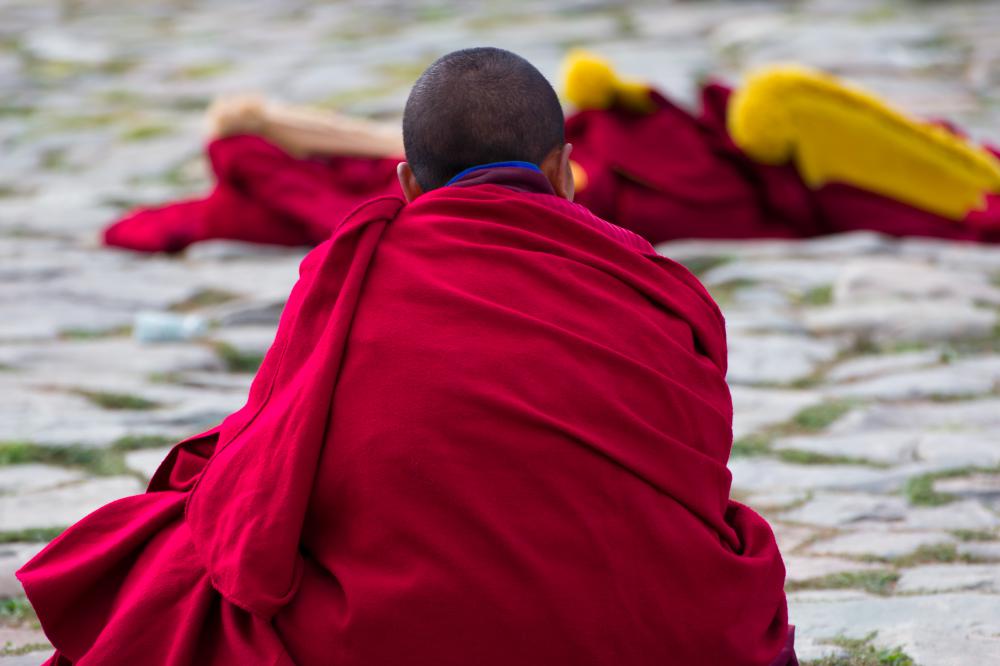At WiseGEEK, we're committed to delivering accurate, trustworthy information. Our expert-authored content is rigorously fact-checked and sourced from credible authorities. Discover how we uphold the highest standards in providing you with reliable knowledge.
What Is Meditation Art?
According to many spiritual schools of thought, the physical world that seems so real is, in fact, simply illusion hiding a deeper and more profound reality. The term meditation is very broad and has hundreds of interpretations, but most will agree that the purpose of meditation is to remove oneself from mundane distractions in order to recognize the holiness in all things. Meditation art can assist seekers toward this deep state of serenity. Alternatively, meditation art can also be inspired by what is realized during mediation and remind the seeker of truths.
One of the better-known forms of meditation art was created by Tibetan Buddhist monks working in silent groups for many weeks at a time. The medium is colored sand, and the message is the essential oneness of all things. Mandalas are incredibly complex; each grain must be precisely laid using a funnel or other delicate hand tool. The mandala shape is traditionally a square with four entrances, or gates, that lead to a circle within which is a stable, unmoving center and around which all else wheels. Mandalas, like most forms of meditation art, are highly abstract and charged with symbolic meaning.

With mandala creation, the journey is the goal, and the creation of art, like every other element of earthly life, should be continuous and ever changing rather than objectified and, once completed, left to stagnate. For this reason, when it is determined that the monks have reached a stage of completion, the mandala continues to represent the circle of life as it is ritualistically destroyed, reminding all that the world in which we partake is simply the first layer to increasingly sacred states of being. Additionally, this is a reminder to onlookers that pride or egotistical satisfaction in one’s creations separates, rather than unites, all things.
Twentieth-century psychologist and psychiatrist Carl Jung, whose theories of the collective unconscious and work with what became known as Jungian archetypes, infused the study of the human psyche with a spiritual essence. He was himself a creator of meditation art mandalas. On many occasions, he stated that mandalas are representative of the hidden, unknown self. His mandalas, which were paintings rather than sand sculptures, were a way for him to access what he was ignorant of within himself in order to integrate it into a whole fabric.
Many Hindus, Christians, and followers of other religions also practice forms of mediation art, simultaneously creating a sacred space through the making of a drawing, painting, or sculpture. The repetition of the use of a pencil, brush, or chisel is helpful in focusing the mind and minimizing distractions into a distant background. All that becomes meaningful is the creation of creation, and through it, the doorway between the inner self and the external, eternal, and unifying cosmos becomes the only true reality.
AS FEATURED ON:
AS FEATURED ON:











Discussion Comments
@Ana1234 - I just want to add that you don't need to be a monk to use art in mindfulness or as a mediation technique. All you need is some paper and crayons and a willingness to find some quiet and some space for yourself.
Some people like to color in line art, but it's just as nice to draw your own pictures, whether they happen to be in traditional mandala format, or just whatever happens to come to mind as you meditate.
@Mor - I guess it depends on the purpose of the art though. If its purpose is to calm the mind and symbolize the fragile nature of reality, then it makes perfect sense for it to be destroyed after it is finished.
Also, since the monks work with sand, and often in very large spaces, it isn't really practical for the work to be kept very long anyway. If you want to see them, then you can go and see the next one they make, but it wouldn't be there if they hadn't swept away the previous one.
Which is why destruction is good as a part of meditation and art, even if you don't have a greater philosophy that demands it. By getting rid of the older works you can make room for the new ones.
In theory, I like the idea of ritualistically destroying art when it is finished as a symbol like the monks do with their mandalas. But they are so beautiful it hurts to think that there have been thousands or tens of thousands of them carefully built and then wiped away so that no one would ever know them.
I've heard of artists deliberately destroying their art so they don't get too attached to it or too hung up on it, but those of us who are not artists would appreciate being included and for that you need to actually keep the art so we can see it.
Post your comments